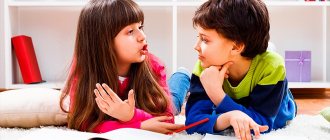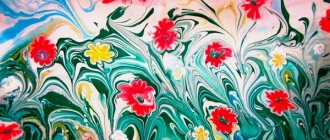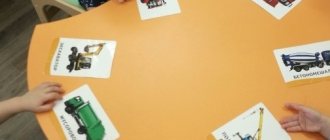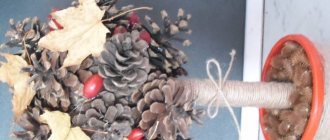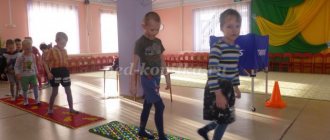The emphasis in modern education of preschool children is on developmental education. Math classes are no exception. The formation of elementary mathematical concepts develops personality, intelligence, logic and abstract thinking. It sharpens attention and memory, develops speech and promotes the most comfortable integration of the baby into the world around him. Fun math for children 3-4 years old will help develop qualities such as curiosity, goal achievement, and discipline. Introduces spatial and temporal logic.
What does mathematics teach 3-4 year old children?
Every educated parent wants to understand how well their child is developed. Are you missing any skills that are important in the modern world that you should focus on? To adequately assess children's knowledge and skills, you need to know what today's education system requires of them.
Mathematics for three-year-old children
Mathematics at 3 years old in kindergarten is not difficult. Children should:
- Master working with numbers within five. This is both an ordinal and a reverse count.
- Understand what this or that number consists of (for example, 5 is 4+1).
- When counting, use fingers, counting sticks, and other available objects.
- Correctly use the names of ordinal numbers, as well as cardinal numbers in the names of numbers.
- Recognize written numbers and be able to write them yourself.
- Name the number that comes before the given one, as well as after it.
- Use the terms “more”, “less”, “the same”. Clearly understand the difference between them.
- Master orientation in space (for example, show on a piece of notebook where the lines are higher and lower, which are on the left, right, between them, what is in the center, what is above, what is below).
For your information! Children must distinguish objects.
By size:
- Big bigger.
- Small - less.
- Short - shorter.
- Long - longer.
- Tall - higher.
- Low - lower.
- Wide - wider.
- Narrow - narrower.
Math classes
By geometric shape:
- square;
- circle;
- triangle;
- rectangle.
They must find these figures and be able to draw them, name the geometric shape of surrounding objects. Learn to identify their color. Distinguish between a circle and a ball, a square and a cube.
Card index of FEMP games for children 2–3 years old
Elena Torishnaya
Card index of FEMP games for children 2–3 years old
Math games for children 2, 3 years old
At the age of 2 or 3 years, the child develops elementary mathematical concepts. He is already familiar with the basic directions: forward, backward, up, down, sideways; is able to distinguish objects by size (large, small, the same), identify their many (one, two, many).
It is useful to have sets of identical toys, for example, wooden Christmas trees or mushrooms. Children really like ordinary nesting dolls, which can also be used for story games.
Find a match
The game develops attention, perception, ability to compare
Necessary equipment: cards with drawn paired objects, or paired toys. You can use special kits purchased in the store.
Place cards (toys) in front of the child and ask him to find a suitable pair for each item.
Help me harvest
The game promotes classification skills
Necessary equipment: dummies or pictures of vegetables and fruits.
Arrange vegetables and fruits (or pictures with their images) mixed. Ask your child to collect and place fruits in one basket and vegetables in the other.
Then you can sort vegetables and fruits by type.
Two roads
The game helps develop classification skills
Necessary equipment: cardboard or paper, cars of different sizes.
Cut two strips of different widths from cardboard (paper). Explain to your child that a narrow strip is a road for small cars, and a wide strip is for large cars.
Show how you can determine which stripe is wider by overlapping stripes.
Ask why a large car cannot drive on a narrow road.
Drive your cars on the roads.
By gluing strips of different widths together, you can build an entire network of roads.
Choose the road
The game promotes the development of classification skills and develops the ability to compare.
Necessary equipment: cardboard or paper, cars of different sizes.
Cut two strips of different widths from cardboard (paper). Explain to your child that these are roads for cars.
Ask him to choose cars for which the narrow road is suitable. And vice versa, choose a road along which this or that car can drive.
[b]Matryoshka
The game develops fine motor skills and the skills of comparing objects by size.
Required equipment: a set of nesting dolls.
Almost all children love nesting dolls.
Show your child a large matryoshka doll. Shake her. Open with your child and take out a smaller doll. Put them side by side and compare.
Let the child put the small nesting doll into the larger one and take it out.
Gradually show him all the nesting dolls.
[b]Who is faster
The game helps to master the concepts of “long” and “short”.
Necessary equipment: two cars, ropes.
Tie strings to two cars - a short one and a long one. Give your child a car with a short string.
Offer to see whose car will “get” to the owner first if everyone winds their own rope around a pencil.
By placing the strings side by side, clearly show what is long and short.
Building a tower
The game promotes the development of motor skills, classification, counting, and comparison skills.
Required equipment: cubes of two colors.
Invite your child to build two towers of different colors, after sorting the cubes.
During the construction process, deliberately make mistakes by choosing cubes of the wrong color.
Geometric figures
The game teaches you to distinguish objects by color and shape
Required equipment: five multi-colored circles cut out of cardboard.
Look at one of the circles with your child, telling him: “This is a circle. It is red. What does he look like? Look for round objects in the room. Explore circles of different colors.
After the child has mastered the concept of “circle,” you can move on to other geometric shapes, while expanding the range of colors.
Compare two identical shapes of different colors. Use the association method.
Let's figure it out
The game helps develop classification skills
Required equipment: 3 circles and 3 squares cut out of cardboard.
Mix the shapes. Ask your child to help you select only the circles.
After this, color the circles with one color and use a different color to color the squares.
[b]One - there, one - here
The game promotes the development of fine motor skills and teaches counting.
Required equipment: two containers (buckets, boxes, cubes or small items.
Place the cubes in front of the baby and place two buckets or two boxes. Invite your child to put the cubes into boxes.
Taking a cube in your hand and placing it in a box, say: “One goes into this box, here’s another one into another.”
When the child understands the concept of “one,” start taking two objects at a time: “I will put two cubes in this box, and please put two cubes in another box.”
Much is not enough
The game promotes the development of logical thinking and introduces elementary mathematical concepts.
Required equipment: two identical boxes, cubes of the same color.
Put 10 cubes in one box, and 3 in another. Having invited your child to build a tower or a house, ask: “Please bring me a box that contains a lot of cubes.” If the child is at a loss, help him.
After you have built the towers, compare which one is taller (the one with more cubes).
Repeat the words “many” and “little” more often, using them in different situations.
Hide it in your palm
The game develops the ability to correlate objects by size
Required equipment: small and large balls.
Give the baby some balloons. Say: “Now I’ll show you a trick!” Take a small ball and hide it in your palm. Ask your little one to do the same.
Offer to repeat the trick with a large ball. Explain why a large ball cannot be hidden in the palm of your hand.
Compare the balls with each other, then with the baby’s palm.
Do similar tricks with any small objects.
Pick a lid
The game develops the skills of classifying and matching objects
Required equipment: pots with lids.
Children enjoy spending time with their mother in the kitchen.
While you're cooking, tell your child that you got the lids mixed up and now you don't know which lid is for which pan.
Ask your child to help you choose the right size lids.
Grandma's pancakes
The game promotes the development of matching skills, the ability to systematize objects according to a certain criterion
Necessary equipment: 4 circles cut out of paper with a diameter of 3 cm, 4 circles with a diameter of 6 cm, a box for large circles, a box for small circles.
Come up with a plot for the game. For example, my grandmother baked pancakes, large and small. Big ones for mom and dad, small ones for the grandchildren. But all the pancakes got mixed up. We need to help grandma put the pancakes on plates.
Counting and numbering numbers
The teacher’s task is to understand whether children understand the ultimate purpose of counting and why they are doing it.
Mathematics for children aged 3-4 years has its own characteristics. It is necessary to direct their attention to the study of a serious subject. For this purpose, all kinds of auxiliary materials and presentations are used.
Studying figures in preschool educational institutions
Fairy tales, toys, cubes, pictures (characters from fairy tales and cartoons printed on a color printer will be excellent handouts), lapbooks will also come in handy. They are easy enough to make yourself.
Children must master the names of numbers. But often they do not project this knowledge onto what concerns them. For example, a child knows ordinal counting perfectly, but cannot count his fingers. He simply doesn't connect the two.
Important! The teacher’s task is not only to give the concept of numbering and counting, but also to connect these things with the real world in the child’s mind.
Finger gymnastics classes in preschool educational institutions for children 2-3 years old
We offer you interesting math exercises
First exercise
Take a sheet of paper and a pencil, divide it into two parts. Draw one more square on the right side than on the left.
Second exercise
Look carefully at the picture, it shows geometric shapes, count them and write the answer.
Any picture will enlarge if you click on it:
Third exercise
In this exercise, instead of a question mark, you need to use the signs >, <, =
Example: 5 > 4.
4 ( ? ) 1
2 ( ? ) 6
8 ( ? ) 4
9 ( ? ) 3
6 ( ? ) 5
Fourth exercise
In this exercise you need to place the signs >, <, =
Fifth exercise
In this exercise you need to place the signs >, <, =
Sixth exercise
What numbers make up the following numbers: 6, 9, 7, 4, 5, 8, 2, 3.
Example: the number 6 consists of the numbers 5 and 1.
Seventh exercise
Continue counting. Fill in the missing numbers.
Eighth exercise
Find all the numbers from 1 to 10 in order and connect them with a line.
Ninth exercise
The duckling solved the examples, check and correct the wrong answers with a red pencil.
Tenth exercise
How many objects are there in each picture?
Eleventh exercise
Objects are drawn on the left side, you need to count them and write the required number opposite each line.
Twelfth exercise
Write the neighbors of this number: 3, 4, 7, 2, 8, 6, 5.
Thirteenth exercise
In this exercise you need to solve examples.
Fourteenth exercise
Look carefully at the following picture, different objects are drawn on it, count them and put a sign between them: >, <.
Math exercises
Additional material will be required for math classes. The preschool educational institution recommends “Igrachka” by L. G. Peterson. This teaching aid is intended for use in mathematics lessons for 3-year-olds in kindergarten. These notebooks can be purchased online. It is also recommended to use the technique of E.V. Kolesnikova.
Educational cards
Math for a 3-year-old child begins with pictures. Five cards are made with the numbers 1, 2, 3, 4, 5.
You need to prepare pictures of the same color, but different objects. For example:
- Blue color – car, ball, flower, umbrella, etc. (all the same color).
- Red color – car, ball, pencil, umbrella, etc.
- Yellow color – car, ball, ball, spoon, etc.
- Green color – car, ball, flower, umbrella, etc.
- Black color – car, ball, pencil, umbrella, etc.
- White color – car, ball, flower, umbrella, hare, etc.
This will gather a working presenter to study the initial account. The objects in the pictures must be of different sizes.
Tasks:
- Find all red cards. Find and name each picture.
- Find all yellow cards. Find and name each picture.
- Find all blue cards. Find and name each picture.
- Find all green cards. Find and name each picture.
- Find all black cards. Find and name each picture.
- Find all white cards. Find and name each picture.
After the children have completed the task, you can move on to the next stage.
Further tasks become more difficult. You need to select all the cards where the car is drawn. All cards with a ball on them.
For your information! Having different colors is very confusing for children at first.
Comparison "More-less"
Mathematics for a 3-year-old child, which takes place in a preschool educational institution, includes the study of comparisons. The concepts of “more” and “less” are explained to children. A set of cards from previous lessons is used:
- Find all the cards with a ball on them. Then find all the cards where an umbrella is drawn. Compare the number of cards. Find which drawings there are more.
- Find all cards with a drawn flower. Then find all the cards with a drawn car. Find which pictures are smaller.
For clarity, you can put together a picture with a car and a flower. Which pictures will be left without a pair, those and more. The ones that ended earlier are smaller.
Studying the concept of “The same amount”
At the beginning of the lesson (if someone is celebrating their fourth birthday), the parents of the birthday boy brought cake and sweets. How to determine how much sweets each child needs without using numbers? Children express their suggestions.
The term “same” is introduced. The guys practice learning a new word. Problems with similar terms are solved:
- Also;
- equal quantity;
- the same.
Magnitude
Children 3–4 years old learn to compare different objects (blocks, strips of paper, ribbons) in width, length and height, and use the words: “longer - shorter”, “same in length”; “wider – narrower”, “equal in width”; “higher - lower”, “equal in height”; “more - less”, “equal in size”.
Cards for studying quantities “more and less”
At first, children learn to compare objects according to some specific characteristic. So, for example, by placing one ribbon on top of another, the children understand that the red ribbon is longer than the blue one, and the blue one is shorter than the red one.
After children learn to compare quantities and denote them in words, they can play the didactic game “Order”. An adult, on behalf of the doll, asks to bring a tall Christmas tree, a long path, a short ribbon, find a carrot of the same height...
Games on the concept of “more/less” can be bought in the store
Geometric figures
Children 3-4 years old are introduced to the square and circle. To do this, an adult gives each child different colored silhouettes of a square and a circle. Showing, for example, a blue square asks children to find the same figure in themselves. He does the same with a red circle, but does not say the name of the figure. Further examination of geometric figures takes place tactile-motor. The children repeatedly run their fingers along the outline of the figure and say its name.
The easiest way to study shapes is through play.
To reinforce the material, you can exercise the children and offer, for example, to put all the squares on the bottom strip, and the circles on the top; pick up the figure in your hand and name it; put the circles in a tray and the squares in a box or play the games “Guess what’s in the bag”, “Find the house”.
Orientation in space
At this age, children learn to navigate space “from themselves” and learn concepts such as: right (right), left (left), forward (in front), behind (behind), above, below.
When learning orientation in space, parts of the child’s body are taken as a basis: below is where the legs are, above is where the head is, behind is the back, and in front is the face, on the right is the right hand, and on the left is the left. The following exercises will help kids learn to navigate in space: “Wave the chicken with your right hand, then with your left”; “Where did the bunny jump” (up, down the hill); “Pull the flags forward (in front of you), hide them back (behind your back).
Orientation in space using cards
It should be borne in mind that when performing all exercises, all children should face the same direction, and the adult’s movements should be performed in a mirror image.
Time orientation
In everyday life, children learn to navigate time. A good helper will be strict adherence to the daily routine.
An adult introduces children to the parts of the day - morning, afternoon, evening, night. In the process of performing routine tasks, the adult says that it is morning, you and I woke up, washed ourselves, do exercises and have breakfast. Before lunch, you need to say that it is daytime, moms and dads are at work, and you and I are studying, walking, and having lunch.
Toy clock puzzles
To reinforce the parts of the day, you can invite children to look at pictures that will allow them to answer the questions: “What are the guys in the picture doing?”; “When we walk, do we sleep?” When reading works of art, you can invite children to point to a picture that is typical of people’s activities at a certain time of day (day, night, morning, evening).
We hope that all of the above exercises will help adults navigate correctly and contribute to high-quality mathematics classes with preschoolers.
leave a comment
About counting on fingers
At the first stage of learning to count on fingers, you need to firmly grasp all possible combinations. The child should not think about the answer within one hand.
FEMP classes in senior groups of kindergartens according to the Federal State Educational Standard
Attentiveness and memory develop, including tactile memory, because counting takes place in the head. You have to hold several data in memory at the same time. A quick solution depends on intelligence and speed of perception.
Child counts on fingers
Before learning to count on fingers, the child is already familiar with the concepts of “more,” “less,” and “also.” Can count objects in order within five.
Further:
- You need to start with 1+1=2. Children put two fingers together and get 2.
- Then add another finger = 3.
- Add one more to three and get the fourth result (four).
- Add one more finger to four and get five.
Now you can master subtraction:
- Subtract one finger from five and it becomes four.
- Subtract one finger from four and it becomes three.
- If you take away one finger from three, there will be two left.
- Subtract one finger from two and one remains.
The lesson should not exceed 20 minutes. Children get tired quickly. You can diversify the lesson by changing activities - warming up, singing something, solving riddles, and so on.
Important! You can't force it. It is always easier to “lure” someone somewhere than to force them. Elements of play, competition and reward will do more and better than anything else.
